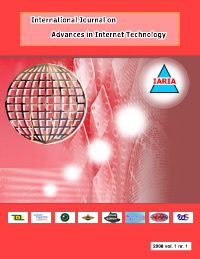ICDS 2018 - The Twelfth International Conference on Digital Society and eGovernments
March 25, 2018 - March 29, 2018
ICDS 2018: Tutorials
T1. Diversity-aware Multilingual Lexical Semantic Resources Management
Dr. Abed Alhakim Freihat, University of Trento, Italy
Knowledge management requires cross-language and multicultural elements. In fact, the management of knowledge is widely spread in different nations, where each culture has its own knowledge base. To connect different language knowledge bases, the construction of a cross-language knowledge base is required to translate knowledge. Building such multilingual lexical resources involves the participation from different cultures and languages which leads in turn to diversity, a fundamental phenomenon in multilingual lexical resources development.
In this tutorial, we introduce Universal Knowledge Core (UKC), A diversity-aware multilingual conceptualization of the world which enables the construction of diverse but coordinated, representations of the world.
In particular, we give an overview of
* Lexical semantic resources
* Managing multilinguality in lexical semantic resources
* The Universal Knowledge Core (UKC)
* Localization of the UKC
* Diversity management in the UKC
T2. Passive Remotely Controlled SAW (Surface Acoustic Waves) Sensors and SAW RFID tags
Prof. Dr. Victor Plessky, GVR Trade SA, Switzerland
In the lecture the main ideas of passive remotely controlled sensors and RFID-tags based on Surface Acoustic Waves (SAW) will be presented. We will discuss “reflective delay line” type of SAW devices, which are similar for both sensor and SAW-tag applications. SAW tags were invented many years ago, but nowadays all conditions are united for mass application of this technology. The devices in the 2.4-GHz ISM band can be routinely produced with optical lithography, and high-resolution interrogation systems (the “readers”) can be built up using highly sophisticated, but low-cost RF-chips. The SAW tags can overcome semiconductor-based analogs in many aspects: they can be read at a distance of a few meters with readers radiating power levels 2 to 3 orders lower, they are cheap, and they can operate in robust environments. Passive SAW tags can be easily combined with sensors. Even the "anti-collision" problem (i.e., the simultaneous reading of many nearby tags) have adequate solutions for many practical applications. In this lecture, we will discuss the state-of-the-art in the development of SAW tags. The design approaches will be reviewed and optimal tag designs, as well as encoding methods, will be demonstrated. We will also discuss ways to reduce the size and cost of these devices. A few practical examples of tags using the “time position coding” with 106 to 109 different codes will be demonstrated. Phase-coded devices can further increase the number of codes at the expense of reduction of reading distance. We also discuss new and exciting prospects of using ultra-wide-band (UWB) technology for SAW-tag systems and SAW-sensors. The wide frequency band available for this standard provides a great opportunity for SAW tags to be radically reduced in size to about 1 x 1 mm2 while keeping a practically infinite number of possible different codes. Recent new approach based on Hyperbolically Frequency Modulated (HFM) UWB signals will be discussed in detail with demonstration of new experimental results. Using UWB chirp signals with this modulation allows to increase the reading distance, and to achieve higher sensitivity of SAW sensors.
No preliminary knowledge about SAW is demanded for understanding this Tutorial Lecture.
T3. Research on Smart Cities – Solving Problems of Urbanization
Prof. Dr. Lasse Berntzen, University College of Southeast Norway, Norway
“Smart cities” can be explained from different perspectives. Most definitions emphasize the use technology to provide better services, reduced environmental footprint, more participation, and better quality of life. As a research topic, “smart cities” includes the study of service delivery, environmental policies and technologies, electronic participation, citizen centricity and many other issues. Researchers may explore the “smart city” as a highly complex system, or dive into the many different application areas of “smart city” thinking. The application areas primarily aim to solve problems of urbanization caused, e.g., by heavy traffic, increased energy use, high pollution, and large amounts of waste. But “smart cities” is also about innovation in major public sectors, such as education, health, public safety and social services. The research is often multi-disciplinary, bringing together engineers, computer scientists, environmentalists, urban planners, sociologists, economists, and other academic disciplines.
Inexpensive hardware platforms such as the Raspberry Pi, Intel Edison, Arduino, paired with ecosystems of sensors, enable us to deploy sensor technology on a large scale. The sensor data, combined with data from open data sources and social media, can be analysed and used for predictions and decision-making. New visualization techniques make results easier to understand by both citizens and decision-makers.
Infrastructure, both fixed and mobile, let citizens access services, report problems, and engage in democratic processes. Mobile devices and smartphones provide access from everywhere at any time. Smart meters provide almost real-time information on energy use, and make it possible to adjust power consumption according to costs.
Several large global companies are marketing “smart city” solutions. Their focus is mostly on technology and integration of subsystems into a holistic solution for managing and running the city.
But “smart cities” reaches far beyond technology. “Sustainable smart cities” is about energy efficiency, reduced environmental footprint, and better traffic solutions. “Shared smart cities” is drawing attention to innovation practices of smart cities. “Smart places” is advocating smart city values as universal, independent of city size. Citizens choose smaller places to get cleaner air and better quality of life, and they certainly need digital services even more than citizens of the large cities.
The tutorial will first examine examples of conceptual frameworks and efforts to benchmark smart cities. The tutorial aims to show the broad spectrum of research on smart cities. Some projects will be described in detail, including a solution for air quality monitoring, a solution for traffic monitoring, a study of the role of citizens in smart cities, and a project to improve citizen participation.




























































